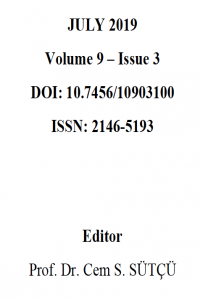Abstract
In this study, the aim is to evaluate the compatibility between the virtual try-on result with the actual
try-on result by comparing the try-ons of a garment produced from knitwear fabric in actual and
virtual environments. The patterns of the garment to be produced in accordance with this aim, were
prepared by the researchers and after sewing prototype product with knitwear, the try-on was made on
the real mannequin who has been taken measure body sizes on. Afterwards, the prepared patterns were
transferred to the computer environment by digitizing in the Gerber Accumark program and the virtual
trying-on was performed on the mannequin which created in V-Stitcher which is a 3-dimensional
virtual simulation program. For the accordance between the virtual try-on and the actual try-on, a
virtual mannequin has been created with the standards of the person who used for the body
measurements. In addition, the knitwear fabric used in prototype production has been defined in the
system by performing tests such as bending, stretch and shear parameters for carring the same
characteristics with actual try-on. The compatibility of the virtual rehearsal and the actual rehearsal
was assessed based on expert opinions. As a result of the research, it was determined that the results of
the virtual rehearsals of the clothes produced from the knitwear are compatible with the actual
rehearsal results.
Keywords
References
- Ahlström, Pär & Westbrook, Roy. (1999). “Implications of Mass Customization For Operations Management”, International Journal of Operations and Production Management, 19 (3), s.262-274. https://doi.org/10.1108/01443579910249705. Browzwear kullanım klavuzu, 2010. Bye, E. ve McKinney, E. (2010). “Fit analysis using live and 3D scan models”. International Journal of Clothing Science and Technology, 22 (2/3), 88–100. Gürsoy, F., Doğan, S. Kılınç, N., (2016). “Comparison Of The Try-Ons Of A Garment Produced From Rize Fabric (Feretiko) In Actual And Virtual Environments”. 7 th International Istanbul Textile Conference, Anadolu’ya Doku “N” an Bezler, BEZCE 2016, 869-878. Fan, J., Yu W. ve Hunter, L. (2004). “Clothing appearance and fit: Science and technology”. Cambridge: Woodhead Publishing Limited and CRC press LLC. Iqbal, Muhammad. (2013). Virtual Product Development and Management Opportunities in Fashion Industry, Master of Science Thesis, Tampere University of Technology. Istook, Cynthia, (2008), Three Dimensional Body Scanning to Improve Fit, Advances in Apparel Production, England: Woodhead Publishing Ltd. Cambridge. doi: 10.1533/9781845694463.1.94 Tama, D., Şen Kılıç, A., Öndoğan, Z., Nizamoğlu, S., (2016). “Vücudu Saran Giysilerin Tasarımında ve Giysi Kalıbı Hazırlığında 3 Boyutlu Açınım Sistemlerinin Kullanılabilirliği”. Çukurova Üniversitesi Mühendislik-Mimarlık Fakültesi Dergisi, 31 (ÖS2), s.169-174. Vuruşkan, Arzu & Bulgun, Ender. (2013). “Fit Analysis for Made-to-Measure Garments”, Tekstil ve Mühendis, 20 (90), s.42-53. http://dx.doi.org/10.7216/130075992013209005. Yeşilpınar, S. ve Bulgun, E., (2007). “Garment fitting problems of Turkish females towards mass customization”. Proceedings of Autex, 2007, Tampere University of Technology, Finland.
Abstract
References
- Ahlström, Pär & Westbrook, Roy. (1999). “Implications of Mass Customization For Operations Management”, International Journal of Operations and Production Management, 19 (3), s.262-274. https://doi.org/10.1108/01443579910249705. Browzwear kullanım klavuzu, 2010. Bye, E. ve McKinney, E. (2010). “Fit analysis using live and 3D scan models”. International Journal of Clothing Science and Technology, 22 (2/3), 88–100. Gürsoy, F., Doğan, S. Kılınç, N., (2016). “Comparison Of The Try-Ons Of A Garment Produced From Rize Fabric (Feretiko) In Actual And Virtual Environments”. 7 th International Istanbul Textile Conference, Anadolu’ya Doku “N” an Bezler, BEZCE 2016, 869-878. Fan, J., Yu W. ve Hunter, L. (2004). “Clothing appearance and fit: Science and technology”. Cambridge: Woodhead Publishing Limited and CRC press LLC. Iqbal, Muhammad. (2013). Virtual Product Development and Management Opportunities in Fashion Industry, Master of Science Thesis, Tampere University of Technology. Istook, Cynthia, (2008), Three Dimensional Body Scanning to Improve Fit, Advances in Apparel Production, England: Woodhead Publishing Ltd. Cambridge. doi: 10.1533/9781845694463.1.94 Tama, D., Şen Kılıç, A., Öndoğan, Z., Nizamoğlu, S., (2016). “Vücudu Saran Giysilerin Tasarımında ve Giysi Kalıbı Hazırlığında 3 Boyutlu Açınım Sistemlerinin Kullanılabilirliği”. Çukurova Üniversitesi Mühendislik-Mimarlık Fakültesi Dergisi, 31 (ÖS2), s.169-174. Vuruşkan, Arzu & Bulgun, Ender. (2013). “Fit Analysis for Made-to-Measure Garments”, Tekstil ve Mühendis, 20 (90), s.42-53. http://dx.doi.org/10.7216/130075992013209005. Yeşilpınar, S. ve Bulgun, E., (2007). “Garment fitting problems of Turkish females towards mass customization”. Proceedings of Autex, 2007, Tampere University of Technology, Finland.
Details
| Primary Language | English |
|---|---|
| Journal Section | Makaleler |
| Authors | |
| Publication Date | June 25, 2019 |
| Submission Date | March 14, 2019 |
| Acceptance Date | May 12, 2019 |
| Published in Issue | Year 2019 Volume: 9 Issue: 3 |


